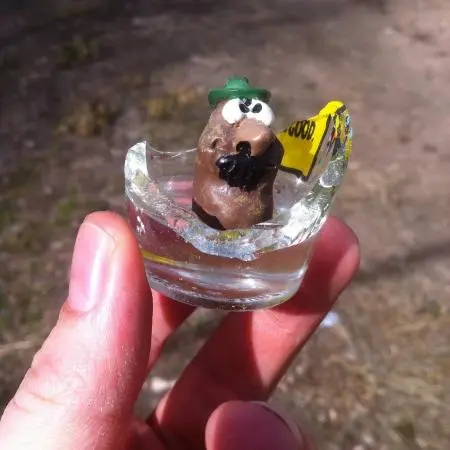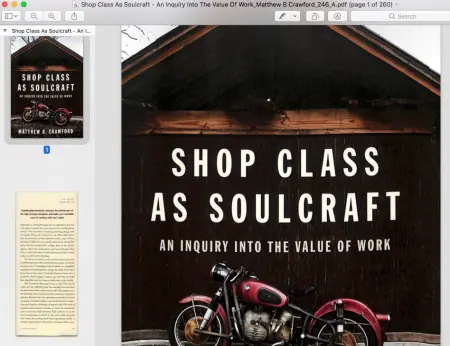I moved apartments three times in a little less than three years.
There were some tough losses as a result of all these moves. Some losses were tragic accidents:

And some losses were on purpose.
Every move, your definition of a “must-have” item gets tighter and tighter. Your first move, you take everything. Your third, you figure, “Eh, I can get by as long as I have two pairs of underpants. One to wear, one to wash while I wear the other.”
Of everything that’s been downsized, my book collection has been hit the hardest.
There’s another move on the horizon. And this one’s a doozy.
As you might imagine, between writing and librarian-ing, I’ve got a big-ass book collection. And as you might imagine, this is a curse when it’s time to move. Why couldn’t I take on a hobby that was lighter? Like...I don’t know, some kind of styrofoam-based hobby?
I decided it was time to give serious thought to digitizing some of my collection.
The DIY Approach
Being a lone wolf, a rebel, a no-time-for-backup kinda dude, I started to look at book digitizing options I could handle myself.
I looked at a few methods online, and most of them involved some contraption that cradled the book, and then you hooked up a camera and photographed the pages. And then—
Sorry, I nodded off there. Just the thought of that process was SO BORING. Plus, by the time I photographed, cropped the images and stitched them together...couldn’t I just READ the book? And I’ve got a move on my hands here. I don’t have time for a process that’s only slightly faster than re-copying books by hand.
Then I came across something called destructive scanning.
The method works like this: You know how in Mortal Kombat, Sub-Zero will rip out a dude’s spine? You do that to your book, throw the pages in a scanner with a feeder tray, and bam, you’ve got a digital book.
This method has the drawback of destroying your books. BUT, it has two big advantages. One is the speed. The other is you get to use a power tool.
You clamp down your book (vice) and cut the spine off (saw). This separates the pages and allows you to run them through your typical office scanner’s feeder tray, which means you don’t have to hand scan each page.
There is another drawback to this method. It’s mostly in the inadequacy of scanning technology.
Even a decent scanner starts to struggle somewhere in the neighborhood of 200 pages. And most of your books are longer than 200 pages.
What’ll happen is something will jam. And then you have to re-order everything, re-scan, and wait and pray and pray to a tech-savvy deity of your choice that the scanner doesn’t get to about page 199 and jam again, in which case you start all over.
That’s how I ended up scanning batches of 50-100 pages. And getting them mixed up, out of order, and deciding that maybe I didn’t even want to read these stupid books anyway.
Paying For It
Book scanning is like getting food. If you’re mostly short on money, you do it yourself, and you buy stuff like bulk beans that you have to pick the stones out of. If you’re more short on time than money, you buy a plate of restaurant food for higher cost but lower time investment.
There are a bunch of companies that offer book scanning services. I’ll be quick about my selection process: there was one company that had a price where the scans were reasonable. Most would charge several HUNDRED dollars to scan a box of books. For that price I could buy them electronically or just toss them and buy them again at a lower price.
One company, though, had a price that I’ll call not-unreasonable.
The math is tricky, but what you need to know is there’s a charge per book, plus a charge per “book unit.” A book unit, in this case, is 200 pages. So a book that’s 201 pages, that’s two book units.
It took a couple weeks, and then I got a Dropbox link with my scans. And they looked really, really good. They scanned the covers, the flaps inside the dust jackets. They scanned and cropped everything. It looked really great on the screen. I was surprised. Turns out that a professional is a lot better at this than I am with my crooked-ass self scans.

The company was also pretty conscientious. I got an email saying I’d miscalculated, and they owed me 78 cents.
More cost than doing it myself, but way less aggravation, way less wasted time, and better scans. It’s almost magic. You send your books off, they vanish, and they return to you in a new form.
Books That Make Good Candidates
Regardless of your scanning choice, I don’t recommend scanning anything and everything. There’s some stuff that I’d hang onto or skip.
Let me guide you through your scanning decisions.
Pile everything together and go through it by hand. Don’t just look up at the shelves. Touch the books. This is like The Life-Altering Magic of Cleaning Shit or whatever that book is called. That title always bothered me. It’s a bit long for a minimalist, isn’t it?
Beloved Books: Your first pulls are books that you love as objects. You got this one autographed, this one has a story behind it. Stuff that you love as much as an object as you do a book. Hang on to that stuff.
Paperback Classics: Don’t send these. Do not send The Old Man and the Sea because it’s been on the shelf and you can’t get to it. These sorts of books are so, so cheap and plentiful. You’ll find another copy. Don’t waste your cash getting something scanned if it’s at every bookstore and library ever. If you’re looking to get rid of stuff like this, donate or toss it, and then get a new one later.
Format-heavy books: If you like your Chris Ware comics, I wouldn’t necessarily suggest scanning. It’s not the worst thing in the world, but it’s not going to please the same way. House of Leaves doesn’t make for a great digital read.
Length: If you’re looking to scan a pile, I’ll recommend that you go through and find books that are as close to the service's page limit without going over as possible. If you do it that way, you maximize the value of your scans. If a book that’s 299 pages costs the same amount as a book that’s 201, the closer you get to that 299, the better.
To-Reads: If you haven’t read them yet, order your books by desire. How badly do you want to read this or that one? Send in the ones you have a less urgent desire to read, and just plop down and read the ones you want to get to right away. Also, anything you can tear through quickly, read them instead of scanning.
Legalities
Well, I’m not an expert here. But I’ll say this:
What you’re doing here seems less morally problematic than ripping a CD you paid for and listening to it on whatever gizmo you use to play your music. The reason being, when you transfer a book to a digital format, you also sacrifice the original book. When you rip a CD, you’ve duplicated the work.
It DOES make the sharing of files a lot easier, “sharing” being the friendly term we use for “bootlegging.” “Sharing” makes it sound like I’m Jesus and I’ve figured out a way to multiply loaves, when the truth is I’m more of a Robin Hood, but less heroic, shitty at archery, and instead of screwing that Sheriff dude, I’m screwing an artist I supposedly love. But I DO look good in green.
My advice is that if you choose to digitize your books, do it, hang on to the files locally, and keep your mouth shut about it. Don’t bend and send the files to your buddies, your classmates, whoever. Once they know you’ve got this easily-accessed treasure trove, you’ll never rest.
Deal With The Empty Shelves
Most people leave this part out. But it’s weird. If you think of yourself as a book person, you scan your stuff, and then you’re naked, no longer surrounded by books.
The biggest fear people have in getting rid of books is that this somehow violates who they are. It’s an addict mindset, part of what addicts struggle with. “I don’t know who I am if I’m at a concert without a beer.” “I don’t know how to exist at a party without a drink.”
You’re still a book person. You’re just a different kind of book person, and you have to recognize what matters is reading the books. Enjoying the books. Not displaying them on your walls. Not that other people know how much you love books.
It’s like truck nuts. You know, those testicles that hang from the back of a truck? That’s a redneck-y way of saying, “I am ballsy.”
But the truth is, anyone who possess the qualities usually summed up as “ballsy” has no need to display fake balls on the back of their vehicle.
Anyone “ballsy,” you’ll know it when you meet them, even if they get out of a champagne colored Beetle with daisy decals on the headlights.
Likewise, if you’re a book lover, people will figure it out. You don’t have to dangle your reading habits out in the world for every motorist to see.

About the author
Peter Derk lives, writes, and works in Colorado. Buy him a drink and he'll talk books all day. Buy him two and he'll be happy to tell you about the horrors of being responsible for a public restroom.







